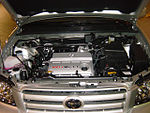By the end of 2006 there were about 15 hybrid vehicles from various car makers available in the U.S. By May 2007 Toyota sold its first million hybrids and had sold a total of two million hybrids at the end of August 2009.
Below is a comparison of the Toyota hybrid models.
| Features | Prius |
Prius |
Prius |
Prius |
Camry |
Highlander |
Highlander |
|---|---|---|---|---|---|---|---|
| Release date | December 1997 (Japan) 2000 (worldwide) |
August 2003 | May 2009 (Japan) June 2009 (US) |
December 2015 | May 2006 | July 2005 | September 2007 |
| US model year | 2001–2003 | 2004–2009 | 2010–2015 | 2016– | 2007– | 2005–2007 | 2008– |
| Base price | US$19,995 | US$22,000 | US$22,000 | US$24,685 | US$26,480 | US$33,000 | US$34,700 |
| EPA-estimated city fuel economy | 42 mpg‑US(5.6 L/100 km; 50 mpg‑imp) | 48 mpg‑US(4.9 L/100 km; 58 mpg‑imp) | 51 mpg‑US(4.6 L/100 km; 61 mpg‑imp) | 54 mpg‑US(4.4 L/100 km; 65 mpg‑imp) | 33 mpg‑US(7.1 L/100 km; 40 mpg‑imp) | 28 mpg‑US(8.4 L/100 km; 34 mpg‑imp) (2WD) 27 mpg‑US(8.7 L/100 km; 32 mpg‑imp) (4WD-i) |
27 mpg‑US(8.7 L/100 km; 32 mpg‑imp) |
| EPA-estimated highway fuel economy | 41 mpg‑US(5.7 L/100 km; 49 mpg‑imp) | 45 mpg‑US(5.2 L/100 km; 54 mpg‑imp) | 48 mpg‑US(4.9 L/100 km; 58 mpg‑imp) | 50 mpg‑US(4.7 L/100 km; 60 mpg‑imp) | 34 mpg‑US(6.9 L/100 km; 41 mpg‑imp) | 25 mpg‑US(9.4 L/100 km; 30 mpg‑imp) (2WD) 25 mpg‑US(9.4 L/100 km; 30 mpg‑imp) (4WD-i) |
25 mpg‑US(9.4 L/100 km; 30 mpg‑imp) |
| EPA-estimated drivers fuel economy | 45 mpg‑US(5.2 L/100 km; 54 mpg‑imp) | 47.5 mpg‑US(4.95 L/100 km; 57.0 mpg‑imp) | 48.7 mpg‑US(4.83 L/100 km; 58.5 mpg‑imp) | 52 mpg‑US(4.5 L/100 km; 62 mpg‑imp) | 36.6 mpg‑US(6.43 L/100 km; 44.0 mpg‑imp) | 24.5 mpg‑US(9.6 L/100 km; 29.4 mpg‑imp) | |
| Engine | 1.5 L 1NZ-FXE I4 Atkinson cycle |
1.5 L 1NZ-FXE I4 Atkinson cycle |
1.8 L 2ZR-FXE I4 Atkinson cycle |
1.8 L 2ZR-FXE I4 Redesigned Atkinson cycle |
2.4 L 2AZ-FXE I4 Atkinson cycle |
3.3 L 3MZ-FE V6 | 3.3 L 3MZ-FE V6 |
| 0–60 mph (97 km/h) acceleration | 12.6 s | 10.8 s | 10.0 s | 9.6 s (Zero to 60 Times) | 7.3 s (R&T, 5/06) | 6.6 s (Motor Trend) | n/a |
| Engine output | 70 hp (52 kW) / 82 lb·ft (110 Nm) | 76 hp (57 kW) / 85 lb·ft (115 Nm) | 98 hp (73 kW) / 105 lb·ft (142 Nm) | 95 hp (71 kW) / 105 lb·ft (142 Nm) | 147 hp (108 kW) / 138 lb·ft (187 Nm) | 156 kW (208 hp) | |
| Electric motor output | 44 hp (33 kW) / 258 lb·ft (350 Nm) | 67 hp (50 kW) / 295 lb·ft (400 Nm) | 80 hp / 295 lb·ft (400 Nm) | 71 hp (53 kW) / 120 lb·ft (163 Nm) | 45 hp | ||
| Net power | 60 kW (80 hp) | 80 kW (107 hp) | 110 kW (134 hp) | 90 kW (121 hp) | 140 kW (187 hp) | 201 kW (270 hp) | |
| Traction battery power | 33 kW (44 hp) | 21 kW (28 hp) | 27 kW (36 hp) | 53 kW (71 hp) | 30 kW (40 hp) | 45 kW (60 hp) | 45 kW (60 hp) |
| Requires premium fuel (91octane(R+M)/2 ) | No | No | No | No | No | No (however, premium recommended) | No |
| EPA/CARBemission certification | Tier II Bin 3/AT-PZEV | Tier II Bin 3/SULEV | Tier II Bin 3/SULEV withAT-PZEV | Tier II Bin 3/AT-PZEV | Tier II Bin 3/AT-PZEV | Tier II Bin 3/SULEV | |
| Smog forming emissions compared to average new vehicle | 75% less | 80% less | 80% less | 80% less | 80% less | 80% less | 80% less |
| Maximum seating | 5 | 5 | 5 | 5 | 5 | 7 | 7 |
- Note: Miles per gallon estimates are those provided by the United States Environmental Protection Agency (EPA) and are the 2008 revision of the original numbers.
- Hybrid access to US HOV lanes varies by US state. Factors can include total/average miles per gallon rating from the EPA, type of technology used, and/or date of vehicle registration with the relevant state authorities. (Several states have begun restricting HOV lane access by hybrid and clean-fuel vehicles due to crowding.)
- Traction battery power is the amount of power available from the electric portion of the Powertrain without the aid of the Internal combustion engine (ICE). This is generally limited by the Traction battery rather than the electric motor(s).
SOURCE: wikipedia
